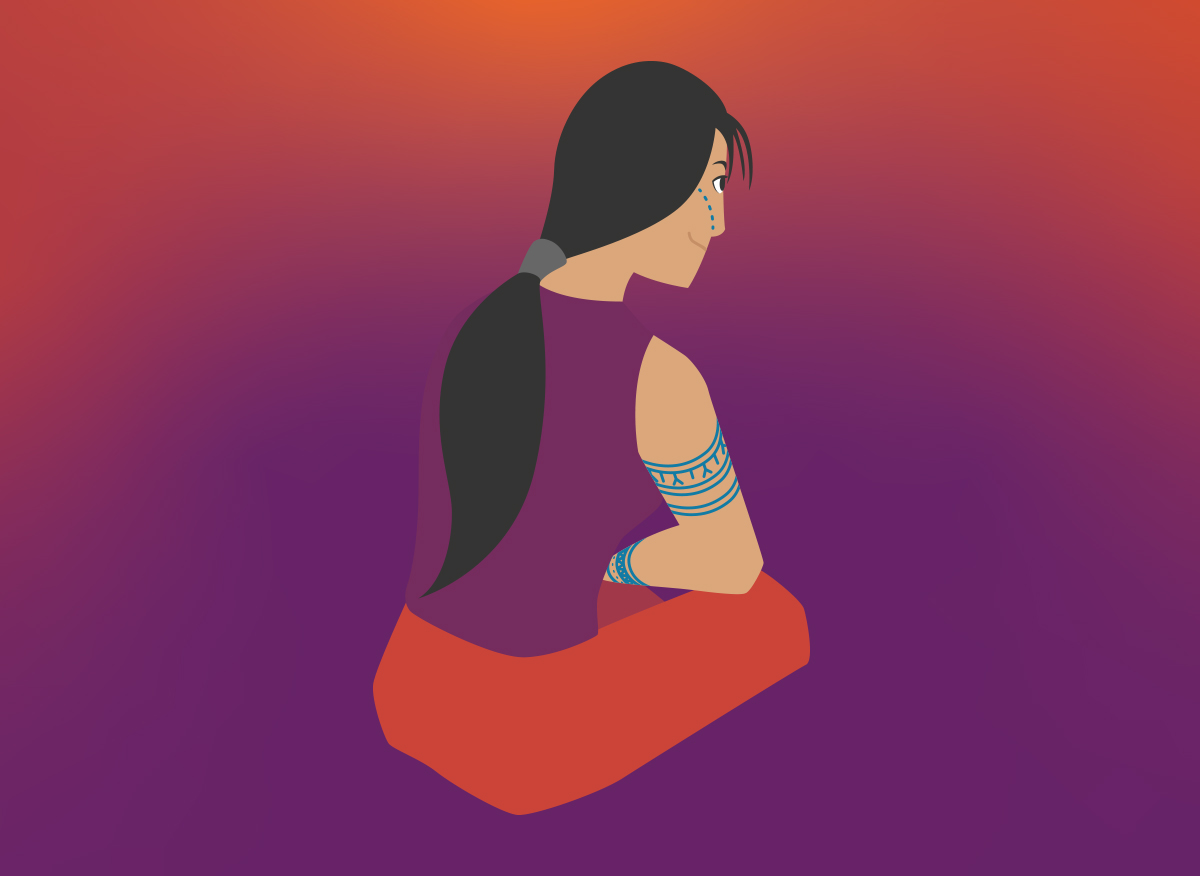Despite the Calls to Action of the Truth and Reconciliation Commission, many universities are only making superficial efforts to integrate Indigenous languages into their curricula. How can universities play a leading role in revitalizing Indigenous languages?

A history of marginalization
As one navigates their way through a university campus and its hallways nowadays, one may notice the signs in Indigenous languages that have sprouted up. This is a response to the Truth and Reconciliation Commission’s Calls to Action regarding the use of First Peoples’ languages along with English (and French in bilingual institutions) on buildings, rooms, and slogans.
Although this may seem like a positive sign that universities are on a road to decolonization, delving deeper into university policies reveals that approaches to Indigenous language programming remain entrenched in colonialism. Yes, several undergraduate degree programs in Indigenous studies now exist and these typically include at least one course on the germane Indigenous language(s). There are some noteworthy Indigenous language programs at First Nations University of Canada, Algoma University, and the University of Alberta.
In Ontario, one would expect even more extensive Indigenous language programming, considering the province is home to about 60 per cent of those in Canada who speak one of three major Indigenous languages: Ojibwe, Cree, and Ogwehoweh (Iroquoian languages). That is roughly 26,000 speakers. However, apart from Algoma University, there are no other degree programs on Indigenous languages in Ontario except for Six Nations Polytechnic’s Ogwehoweh languages program.
Two universities that have offered Indigenous language courses for over 30 years have only minors, one on Algonquian languages, and the other on Nishnaabemwin. The latter was created only recently. Such initiatives are well overdue; comprehensive programming was already urgently needed 40 years ago. Moreover, these initiatives will not suffice as they alone cannot address an equally urgent need—production of comprehensive language learning resources. An overview of systemic factors that shape faculty complements explains why.
Indigenous language courses typically are a small component of a broader Indigenous studies program. A specialization or major in this field generally requires that students take an introductory course in an Indigenous language. This enjoys a healthy enough enrolment as it also attracts students from other programs needing an elective. That and other factors make an enrolment drop in higher-level Indigenous language courses almost inevitable and those courses often not viable.
Of the students who begin with the serious intent to learn their language, a number discover that learning a second language as an adult is very challenging. The prospect that postsecondary institutions will ever be able to create degree and diploma programs taught in Indigenous languages, one of the Truth and Reconciliation Commission’s Calls to Action, seems worryingly slim. How can universities facilitate the pursuit of that dream?
Full-time faculty positions essential
The solution requires a multi-pronged strategy. A key feature is stable full-time faculty positions that are not reliant on external funding subject to the vagaries of governments’ priorities. Without these, the survival prospects of Indigenous languages will be vastly diminished. Indigenous languages will remain in the form of some rote expressions and phrases of the “My name is” and “I come from” variety uttered simply as emblems of one’s identity. That is the extent of the speaking ability in their language that most Indigenous youth and adults under 40 now possess. Their learning has largely been constrained to Indigenous language as a second language, the only means most have to learn their ancestral language. The kindergarten to Grade 12 curriculum and/or an introductory course in university do not afford sufficient exposure to foster full linguistic vitality.
Comprehensive learning resources and applied research in how teaching methods might be tailored to Indigenous languages are vitally needed. These issues can be addressed only if there are faculty in stable tenure-stream and tenured positions. It is in this regard that the nature of the academy—a culturally foreign edifice—is highly obstructive.
Faculty hiring criteria constitute one major roadblock. Historically, very few mother-tongue speakers of Indigenous languages obtained university degrees. Those who did, have them in non- Indigenous language fields since no degrees in Indigenous languages existed at the time. Relevant teacher training programs that have been established (the first around 1980) are certificate or diploma programs that only prepare trainees for certification as kindergarten to Grade 12 Indigenous language teachers. In Ontario, Lakehead’s diploma program is the longest standing while Nipissing’s was established relatively recently.
Generally, few mother-tongue speakers coming out of this type of program have gone on to obtain degrees. Some kindergarten to Grade 12 teachers also teach their Indigenous language in university on a contract basis. In very few instances have mother-tongue speakers without a degree been hired as full-time university faculty to teach their language. They, and the few other Indigenous language professors with graduate degrees, will be in a position to retire within the next five years or so. Indigenous students learning an Indigenous language are keenly aware of the implications this situation holds for them. This has galvanized some to become actively involved in language programming.
Indigenous language revitalization by learners of Indigenous languages
A number of these learners are now actively pursuing Indigenous language revitalization through their own continued, informal studies after obtaining degrees, procuring whatever resources they can find, and creating non-credit programming for their fellow learners. A few are enrolling in linguistics degree programs, some at the graduate level. As a result, some could meet faculty-hiring criteria.
Indigenous language teacher training programs are seeing a decline in the number of mother-tongue speakers—as an aging group, few are inclined to embark on a teaching career—and the programs are increasingly admitting learners of the language. This group tends to go on to bachelor of education programs. However, certificate and Indigenous studies programs typically only have one course on the language available. Clearly, resources to serve ongoing learning needs are critical.
Indigenous language teacher training programs are seeing a decline in the number of mother-tongue speakers.
Although Indigenous languages historically thrived in spoken form, the context of Indigenous lives today makes a large corpus of literature also vital for language revitalization. It would facilitate literacy essential for communication among community members, many of whom reside in urban areas. It can also enable a “reawakening” of languages that are moribund. In the case of a few languages, this is occurring through collaboration between Indigenous communities and linguists who are drawing on documents such as lexicons and grammars of Indigenous languages written by missionaries a century or more ago. Universities should not wait until a language becomes moribund or for technically savvy linguists with access to language preservation archives to come along before initiating concrete actions to help save Indigenous languages.
Learning resources vitally needed
Resources must be created and curricula developed by Indigenous language teachers who are mother-tongue speakers. If more such speakers held tenure-stream and tenured positions, they could develop materials that would help not only their students but also kindergarten to Grade 12 teachers who are not fluent. For instance, this group of people has no resources in Nishnaabemwin (Ojibwe) that they can refer to akin to the Bescherelle handbooks for French. The number of books in Nishnaabemwin that one might find in school libraries is nowhere near the number that exist in French. This corpus—mainly compilations of traditional stories or accounts of historical events told by Elders and transcribed—is growing too slowly in volume and scope, and too haltingly, to reverse Indigenous language erosion.
Performance evaluation criteria utilized by universities inhibit this vital work. The lessons and learning activities Indigenous language instructors develop do not lend themselves to publication in academic journals, a key metric of research productivity. Creative writing, such as short stories that would serve pedagogy, is also unlikely to be deemed scholarly work. Yet, these are the kinds of materials that will foster language revitalization. Linguistics articles about intriguing Indigenous language features and sociolinguistic studies examining the relationships among language, culture, and identity—however compelling they are—will not.
Performance evaluation criteria utilized by universities inhibit this vital work.
No Indigenous community has ever, in the history of its language, had to develop coherent, comprehensive curricula and resources. University administrations need to recognize what this implies for the faculty engaged in this work. Indigenous language faculty draft learning materials on an ongoing basis. The new activities they regularly devise are, in effect, piloted by them, and improved and expanded in subsequent years. They analyze how the intricacies of their language can best be sequenced to facilitate learners’ progress.
Grammatical terms taken for granted in English—verb, noun, adverb, clause, active voice, and so on—have no equivalents in Indigenous languages. Over generations speakers simply acquired their language and none were ever compelled to dissect its features. The specialized terms linguistics has to offer—morphemes, conjunct order, voiced and devoiced consonants, and so forth—likewise lack Indigenous language equivalents. The teacher training programs usually can only introduce pertinent concepts for this field briefly.
Faculty also need to educate themselves further on linguistic concepts, in effect training on the job, to ensure that any explanations they give learners concerning grammar are accurate. Adult learners cannot be expected to internalize the numerous complex transformations entailed in conversing in an Indigenous language solely through hearing copious examples. A Nishnaabemwin verb illustrates what is involved. Mnazaan (He is cooking it) undergoes a radical transformation in a remark like Wegnesh iidik ge-mnazmawaambaane (I wonder what I should cook). Fluency does not mean patterns fall readily into a sequence from least to most complex in instructors’ minds when they go to write a comprehensive curriculum. The problem solving in which they engage is theorizing and the piloting of learning activities research.
Tomorrow will be too late
Any university that does not yet recognize these kind of activities as scholarly in nature needs to. Without that recognition, there will be no materials that can actually facilitate Indigenous language revitalization. Writing academic articles regularly to meet standard performance evaluation criteria takes time away from producing materials that are needed more urgently as the retirement of mother-tongue faculty looms closer. The second-language learners who will need to deliver Indigenous language programming in the future will need those resources. Materials truest to the language can be developed only by those who hear the language—its phonology and phraseology—in their minds the way that mother-tongue speakers do.
Already I get periodic queries from non-fluent Indigenous language teachers in school boards who ask if there are resources they can use to learn more of the language. Already their teaching at the intermediate levels is stunted because of the knowledge they cannot access. Materials developed at universities must be made available to such learners, and to anyone who is striving to learn an Indigenous language. Materials must not be restricted to only those students registered in the university’s courses. For those languages that are even closer to extinction—the situation for most Indigenous languages—such resources are even more crucial.
Unless such work is nurtured and shared beyond an individual university, it will never be possible for Indigenous postsecondary students to enrol in courses taught in their language that are not courses on their language. Without more fundamental changes and support from postsecondary institutions, students who have studied their language from kindergarten to Grade 12 will be stepping into a void if they go to university with the intent of doing further studies in their language. Non-fluent speakers teaching their language will only be able to give skeletal coverage of its vast complexities. This is as unacceptable to the Indigenous community as skeletal coverage of French would be to the Francophone.
Without more fundamental changes and support from postsecondary institutions, students who have studied their language from kindergarten to Grade 12 will be stepping into a void.
The challenge to universities is a tall one given that their rankings are largely determined by the credentials their faculty possess, the scholarly publications they churn out, and the rank they hold, as well as the fact that these criteria have been entrenched in provincially-mandated quality assurance processes.
In the face of such monolithic forces and the financial pressures universities face, it would take a brave institution to make the commitment needed to answer—in a meaningful way—the Truth and Reconciliation Commission’s Calls to Action with respect to Indigenous language preservation and revitalization. Do any dare? Or would doing more than sprinkling Indigenous language signs in a few highly visible places pose too great a risk to one’s ranking? Is dedicating full-time positions to Indigenous language faculty too onerous a cost? Are token symbols that burnish their image as responsive institutions all they are willing to invest in?










